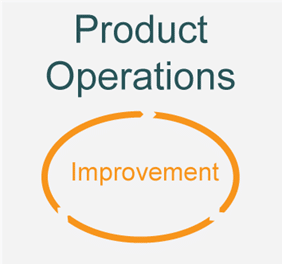
Your company is striving to build excellent products, so you hire Product Managers, Engineers, Architects, and even a DevOps team. You are building the infrastructure and a product your new and existing customers are crying out for. Yet over time, with a bigger team now executing in silos, communication becomes a problem. As a result, processes are breaking, deadlines slip, and team members leave. Product Managers can’t fix the processes and systems, and neither can the Engineering team as they have other responsibilities.
While the concept of scaling or improving Product organizations is not new, many companies (new and old, start-ups and enterprises) still struggle with building their Product teams to ensure that they are effective at every stage of expansion and growth. Whether there is too much or too little data, inefficient processes, or lack of alignment between teams, it’s easy to get bogged down in the Product world these days. And this is why we have seen the rapid growth of Product Operations, as Product teams worldwide strive to build excellent products effectively and efficiently as they scale and improve. But what actually is it?
What is Product Operations?
Product Operations, or Product Ops for short, is an emerging function. It’s a role (or team) often found within Product-led organizations to support strategy execution, define and optimize processes, implement and leverage technologies and integrate data and analytics into every working day. Its mission is to enable Product teams to operate efficiently at scale.
All businesses are different and specific priorities within the Product Operations function may vary based on company maturity, org structure, industry, and the nature of the product itself. But broadly speaking, Product Operations teams should focus on supporting the Product organization in the following areas:
- Processes: supporting and continuously improving cross-functional collaboration through the identification, documentation, standardization, and automation of processes.
- Technologies/ Tools: managing the Product tech stack, establishing internal best practices, and ensuring teams are using those tools effectively.
- Data: collecting, organizing, and analyzing product, process, and process compliance data, enabling the organization to make the most of their insights to make data-driven decisions.
- Infrastructure: maintaining templates, guidelines, internal how-to articles, and other essential resources so that the Product organization can operate efficiently.
- Communications: ensuring product roadmaps, R&D activities, executive reports, and training/ enablement are made visible and accessible by the relevant stakeholders.
What are the benefits?
A natural result of scaling is that communication becomes more difficult across bigger and more distributed teams, processes start to break, and teams lose focus on the most critical outcomes needed. Product Operations teams are the ones who can keep the system running like a well-oiled machine.
Product Operations teams can improve alignment and standardization by aligning the Product organization around the planning and executing of the Product strategy. This could include establishing a planning and execution cadence, building automated dashboards for investments and strategic initiatives, and ensuring launch programs have a framework that any Product Manager can consistently leverage.
Product Operations teams can also increase effectiveness and efficiency by building and systematizing repeatable processes (and automating them through tools such as Blue Prism). Using the right tools and technologies makes the organization more efficient and scalable, freeing up time to focus on more strategic thinking, problem discovery, and data validation. Examples of standardizing repeatable processes include ensuring Product Managers are using a single technology such as Aha! for roadmapping and refining how multiple products and features are launched to the market concurrently. I took this approach at Blue Prism, helping transition the business from a one product on-premise launch strategy to a ten on-premise/cloud product launch strategy on a quarterly release cycle. This resulted in the launch of 9 new products to the market in 8 months.
Finally, Product Operations teams can increase the organization’s scalability by enabling their Product Managers to focus on their core responsibilities and hand-off routine, admin, and support tasks to Product Ops. Examples include taking on more responsibilities across the tech stack, making data and analytics more accessible, and driving process definition and continuous improvements to enable the organization to operate with new and improved processes at scale.
Done effectively, Product Operations teams should work seamlessly in the background, making organizations more effective and efficient while keeping scalability in mind in everything they do. Ultimately, these teams will deliver value by accelerating feedback loops, increasing efficiencies, and improving product/feature adoption.
What does it mean for Product Management?
Building excellent products that users love is not easy. Product Excellence demands a structured approach to Product Management that emphasizes getting the right products to market quicker through deep user insight, a clear product strategy, and an inspiring roadmap. It involves the convergence of vision, strategy, and execution, where Product Operations can directly support Product Managers.
The first pillar of Product Excellence is “vision.” It is all about a shared understanding of what users want and need by deriving product vision from customer insights and maintaining clarity across Product teams. We recommend that Product Managers get directly involved with their customers to capture deep user insights and feedback. To support this effectively, Product Operations teams are the ones who implement and manage those tools and processes that collate, organize, and prioritize this feedback, for example, surveys, product analytics, etc. This has become particularly important as Product Managers have access to increasingly more data than ever before from internal and external stakeholders.
The next pillar is “strategy.” Now, this focuses more on having an effective plan informed by the right vision, which means prioritizing work to be done around well-defined objectives aligned with a product’s strategy. By implementing and managing tools and processes, Product Operations supports Product Managers in defining and pursuing their goals, thanks to their deep knowledge of and access to data, and helps guide them back if they start to veer too far in another direction. Tools like Aha! help Product Managers visualize their entire strategic business and product framework, which they call the “red thread of strategy.”
The third and final pillar is “execution.” Ensuring the entire business rallies around the product roadmap to understand where a product is heading, why, and to be able to plan it effectively. A coherent product roadmap results from cross-functional collaboration and decision-making, communicating the outcomes the Product Manager is striving toward and how they support the organization’s overarching goals. The Product Operations team ensures regular communication with teams and executives across the business, so everyone aligns on the objectives and the Product team’s role in supporting them.
Conclusion
The Product team is playing catchup with other departments – the Project Management Office (PMO) has existed in many businesses for years to improve ways of working on projects. Sales Operations teams are also commonplace, as are supporting functions in other departments aimed at improving their efficiency. However, it could be down to the relative immaturity of Product Management that all sizes of businesses are only now looking to standardize and improve their ways of working.
Either way, as Product teams continue to grow, evolve their ways of working, and get their hands on more and more data, the demand for Production Operations will only continue to accelerate in order to support this. Product Operations might be the new kid on the block, but it will help ensure that Product teams stay focused on strategic work aligned with business outcomes and bring organizations of all sizes and maturity worldwide one step closer to Product Excellence.
Lewis Thorneycroft
Product Operations Lead, Blue Prism





Join the conversation - 2 replies
Great article Lewis. Product Operations as a practice and sometimes (scale dependent) as a team/function is a powerful tool for ‘product management’. As you say, there are several business functions that already have a ‘central’ team that takes care of strategy, operations, continuous improvement, comms and reporting – the PMO for projects and programmes is a good example of this. Product Management can benefit from the same/similar function. The trick is that Product Management spans across most, if not all, business functions. Therefore, having another function in the business that covers the same activities as a PMO but in a broader business context can be a challenge – consider duplication and possible conflict. This is where scale comes in. Larger organisations with multiple portfolios and offers and Product Managers need to work in a more coordinated way, sharing information, aligning on things such as client experience, presenting what they do ‘as one’, and enabling cross- and up-sell of offers through homogeneity of design. Product Operations in this situation is an imperative. Often, in such circumstances, a Chief Product Officer will lead the overall product organisation (portfolio and offers), and the CPO will require a Product Operations function to be most effective. The PO function can then be designed and implemented and operated taking into consideration the interlocks with the other similar functions such as Sales Ops and the PMO, ensuring there is no duplication or contention, and making sure that the entire ‘product’ function operates in the most efficient way possible. In smaller organisations with fewer portfolios and offers, the need for a PO is less important, but what remains important is that some of the activities of the PO are shared amongst Product Managers from different portfolios, perhaps operating as a Community of Practice. In my experience of leading and running product teams I have always had a Product Office that performs the tasks as outlined in this article fo Product Operations, driving consistency and continuous improvement for what can be a dislocated set of product portfolios.
This is really good! Thank you for this, I will definitely look to include this in my Product department!